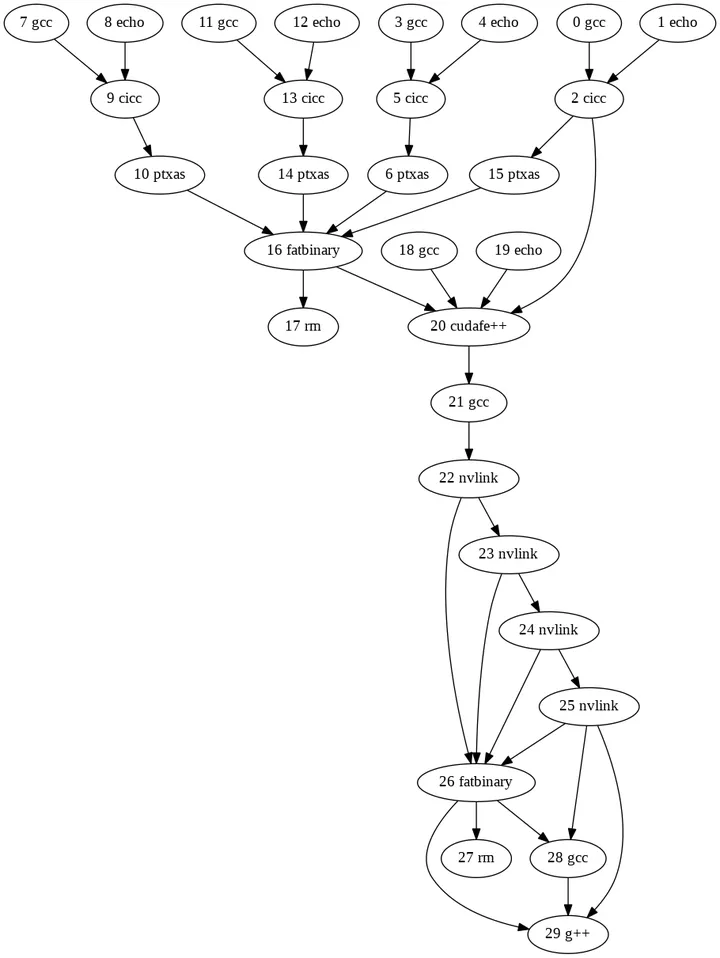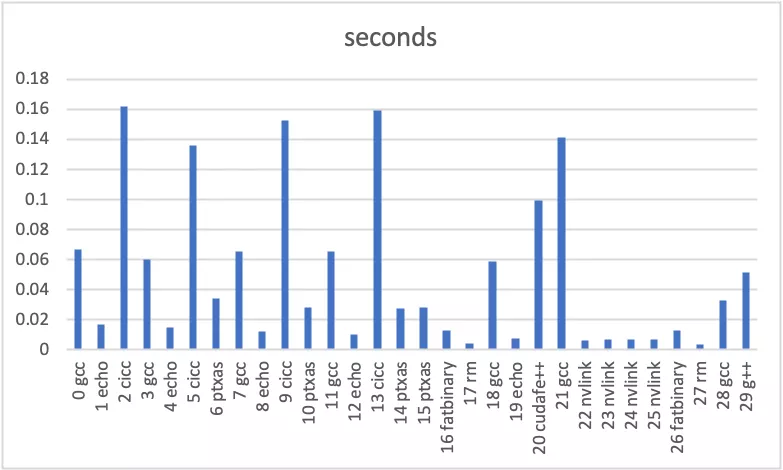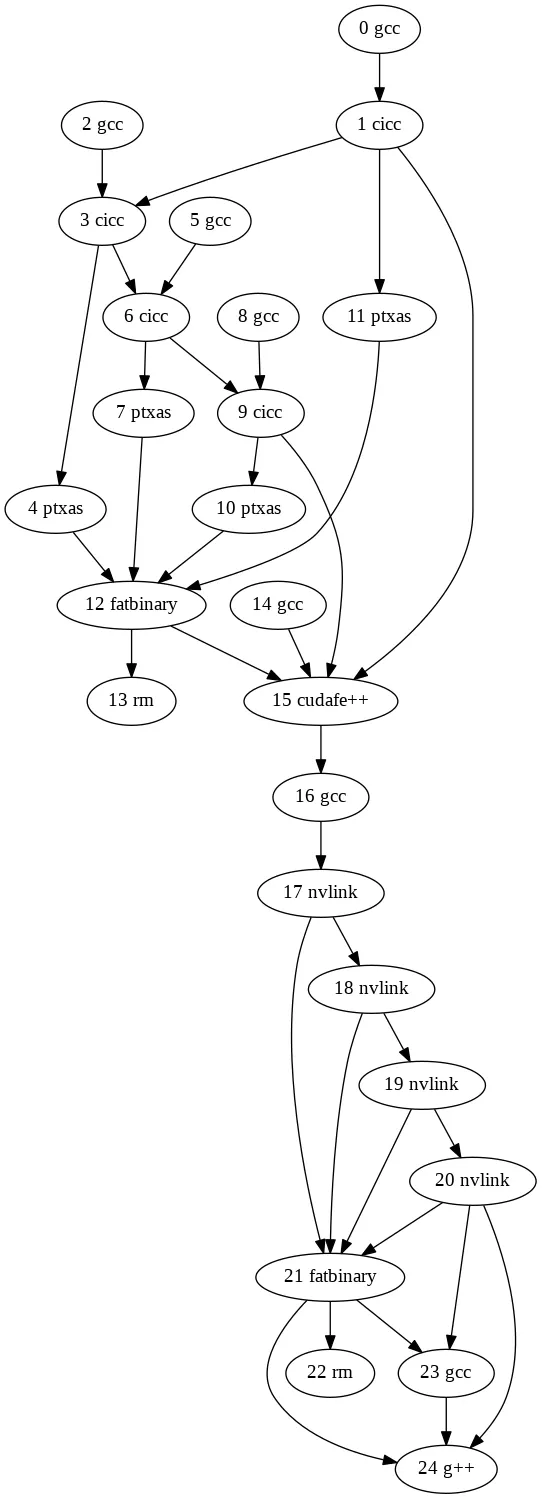Edit (2021-04-29): According to Stack Overflow:
nvccfrom CUDA 11.3 finally supports this out of the box via the-tflag.
CUDA 11.3 was released on 2021-04-15.
This post talks about
fast_nvcc.py, which Nikita Shulga,
Rong Rong, and I brought to
the PyTorch repo in
December, reducing wall-clock build time for builds that use
nvcc to compile large CUDA files for multiple architectures
at once. I first give the motivation and a broad overview of the
approach, and then explore several technical details of the development
process.
Overview
As
documented by NVIDIA, nvcc is a "compiler driver" which manages the
"several splitting, compilation, preprocessing, and merging steps
for each CUDA source file." It parses CLI arguments, creates a plan
for which tools to invoke to do its job (and the CLI arguments to pass
to those tools), and then executes that plan.
The key to our story here is that we can pass nvcc the
--dryrun
argument to make it just tell us the plan, rather than actually
executing it. For instance, let's say we want to compile this simple
CUDA file:
#include <stdio.h>
__global__ void kernel() {
printf("Hello World of CUDA\n");
}
int main() {
kernel<<<1,1>>>();
return cudaDeviceSynchronize();
}
We can run the following to make nvcc tell us what it
would do to compile hello.cu for architectures
30, 50, 60, and
70 (and produce an executable called hello):
$ NVCC_ARGS='hello.cu -gencode arch=compute_30,code=sm_30 -gencode arch=compute_50,code=sm_50 -gencode arch=compute_60,code=sm_60 -gencode arch=compute_70,code=sm_70 -o hello'
$ nvcc --dryrun $NVCC_ARGS
This command runs almost instantly, produces no files, and prints to
stderr something similar to this, listing all
the commands nvcc would run and the environment variables
it would set while running them.
So at this point we can reproduce the behavior of nvcc by running it
with
--dryrun, parsing the output, setting those environment
variables, and running those commands. If we do that, we find that a
significant portion of the total compilation time (see the
"Flags" section below for numbers) is taken by the
gcc, cicc, and ptxas commands, of
which there is one of each, for each architecture (plus three
extra gcc commands to do other things). These
architecture-specific steps are essentially independent of each other,
but nvcc runs them all sequentially, missing out on
concurrency possibilities.
That's where fast_nvcc.py comes in: it serves as a (mostly)
transparent drop-in replacement for nvcc, which works by
taking the output from nvcc --dryrun and running commands
concurrently whenever possible (by generating a dataflow dependency
graph from the /tmp/tmpxft* filenames in the commands). If
you have it on your PATH, you should be able to replace
nvcc ... with fast_nvcc.py -- ... anywhere
(with some exceptions; see the "Limitations" section below).
Implementation
This section discusses several (hopefully interesting?) details about
the
fast_nvcc.py implementation and development process.
Flags
Going along with the theme of working as a standalone script,
fast_nvcc.py provides several CLI flags that I found
invaluable while developing this diff. (If you have it on your
PATH, you can see them by running
fast_nvcc.py --help.) I left these in the final product in
case someone finds them useful in the future.
$ mkdir files
$ fast_nvcc.py --graph=graph.dot --save=files --table=table.csv --verbose=verbose.txt -- $NVCC_ARGS
$ dot -Tpng graph.dot -o graph.png
This populates files and generates
graph.dot, table.csv, and verbose.txt. And if you have dot installed, that last command
generates graph.png which looks like this:

A few notes:
-
The
--verboseflag differs fromnvcc's built-in--dryrunand--verboseflags because it shows the (modified) commands that will be run byfast_nvcc.py(rather than the originals fromnvcc), and because it tries to make the commands more readable by numbering them and spreading each one across multiple lines using Python'sshlex.splitfunction. It's not very friendly for machine consumption, but it's useful for humans, and provides context for the other flags since the numbers are the same as those shown in the output of--graph, for instance. -
The arrows in the
--graphpoint from dependencies to the commands that depend on them, so essentially, the graph shown in the picture above gets run from top to bottom. -
The
--tableflag was added before--save, so all its columns past the first two are a bit redundant (they just give the sizes of files, while--savegives the files themselves). Its second column was useful for finding what to parallelize and what to ignore: see the "Leftovers" section below.
Here's an Excel chart generated from the first two columns of the
table.csv file. This shows us that we are indeed
parallelizing the most time-consuming parts of the compilation:

Tweaks
While the high-level description in the "Approach" section
above is mostly accurate, there were a few tweaks that we needed to make
to get it to actually work. To clarify, the general rule is
that if two commands refer to the same
/tmp/tmpxft* filename, then we make the latter wait for the
former before running. We had a bug at first because some of the
filenames leave off the /tmp at the beginning (i.e. they're
just relative paths starting with tmpxft) but it mostly
works.
The first exception we found was for *.fatbin.c files. As
mentioned in a comment in the fast_nvcc.py source code, the
cicc commands actually refer to such files (which,
incidentally, are the ones that don't start with /tmp)
before the fatbinary command that generates them.
This is because the cicc command simply generates a file
that references (via #include) the
*.fatbin.c file which will be created later, and then when
the file generated by cicc is processed later, that is when
the *.fatbin.c file needs to exist. So in this case, the
rule is: if commands A and
B (of which B is a
fatbinary command) both reference the same *.fatbin.c file,
and A also references a (different) file that
is later referenced by command C, then
C depends on B.
Another exception was for the *.module_id files used by
cicc and cudafe++
commands. This one led me down a very deep rabbit hole. The issue here
is that several commands (including one for each architecture) reference
the same
*.module_id file, with the first cicc command
being passed the --gen_module_id_file flag to generate the
file that is then used (without modifying) by the other commands.
- Running them in all parallel (even after waiting for the first to finish) doesn't immediately work, because even though none of them modify the file, for some reason they conflict when they access it at the same time.
-
An easy "solution" would be to just run the first command,
copy the one file into a bunch of different files (so they have
different names) and then run each of the other commands with its own
unique
*.module_idfilename, but that's suboptimal because it means that you have to run the first twocicccommands (which, remember, are some of the most expensive innvccruns) serially. -
At first we tried just giving each command its own unique
*.module_idfilename and the--gen_module_id_fileflag, so they would each generate their own file and work completely independently. This actually works in most cases! All the*.module_idfiles get slightly different contents this way, since they're all generated by different commands, but usually that doesn't matter. However, it fails foraten/src/ATen/native/cuda/SoftMax.cu, which does a special thing that most CUDA files (at least in PyTorch) don't do.
So in the end we just looked at the contents of some
*.module_id files (they're not very large), took a guess at
the function used to generate them, and replaced the usage of the
--gen_module_id_file flag with a bunch of
echo commands that each create a
*.module_id file with contents similar to what would have
been created by the first cicc command. We know that the last 8
characters of the file contents are definitely wrong: they appear to
probably be a hash of some sort (since they don't (usually) change when
compiling the same file multiple times), but it's unclear what hash
function is being used or what exactly is being fed to that hash
function. So we just take an MD5 checksum (although it would almost
certainly be better to use a cheaper hash function) of the preceding
part of the *.module_id contents, stick it on the end, and
call it a day.
(Fun detour: you can disable these *.module_id shenanigans
via the --faithful flag, and by combining that with the
--graph flag, you can see the less-parallel execution graph
that results!)
$ fast_nvcc.py --faithful --graph=faithful.dot -- $NVCC_ARGS
$ dot -Tpng faithful.dot -o faithful.png

Leftovers
As is plainly visible from the above graphs, this diff doesn't
parallelize
all the per-architecture commands run by nvcc.
Specifically, all the nvlink steps still run serially. But
as the --table data show, this doesn't matter, since
nvlink is basically the fastest part of the whole
compilation. Interestingly, though, architecture 72 is an
exception to this rule:
$ fast_nvcc.py --table=/dev/stdout -- hello.cu -gencode arch=compute_70,code=sm_70 -gencode arch=compute_72,code=sm_72 -o hello | grep nvlink | cut -d, -f1-2
14 nvlink,0.007828212808817625
15 nvlink,0.7020692219957709
As suggested above, nvlink for architecture
72 is two orders of magnitude slower than for any of the
other architectures, and by far the slowest step for any compilation
that includes it. Currently it seems to be the only such anomalously
slow architecture, but if more are introduced in the future, the
sequentiality of the nvlink steps in
fast_nvcc.py may become important. It's unclear whether
it's possible to parallelize those steps, though.
Limitations
Since fast_nvcc.py depends on being able to infer dataflow
dependencies using /tmp/tmpxft* filenames, it assumes the
/tmp prefix. According to
the nvcc docs, there are a few ways that this assumption could be violated:
- if
TMPDIRis set, its value is used instead -
if the OS is Windows,
C:\Windows\temp(or the value ofTEMP) is used instead -
if
--objdir-as-tempdiris passed, the directory of the object file is used instead -
if
--keepor--save-tempsis passed, the current directory is used instead - if
--keep-diris passed, its value is used instead
This limitation could be removed, but we haven't need to address it yet,
so instead, fast_nvcc.py simply warns the user (linking to
the nvcc docs) if any of the above conditions occur. As an
aside, it doesn't appear immediately obvious what the precedence of
these rules would be; perhaps fast_nvcc.py should still
warn if multiple of them occur simultaneously.
Recap
We looked at fast_nvcc.py—which acts as a faster (wall
time) replacement for nvcc when used to compile CUDA files
for multiple architectures at once—and explored several of its
implementation details. Thanks for reading! :)